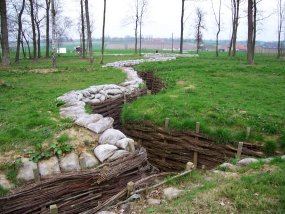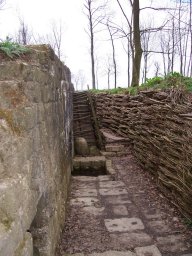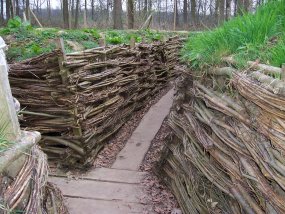
WWII: Maginot Line | Normandy | V-Weapon Sites | Arnhem
Further afield: Crete
| Home Tracing Military Ancestors Travel Advice CWGC Cemeteries Iron Harvest News Book Reviews Glossary Links Contact Me Ypres:
 
|
Core Location 11 – “Bayernwald” German Trenches, Croonaert Wood
Directions – This site is on private property and you will need the gate entrance code from the Tourist Office in the village of Kemmel, to the south-west of Ieper. From Kemmel, follow signs to Wijtschate and take the left turn out of the village to Vierstraat and then the first right when you reach a wooded area. Park your car outside the Croonaert Chapel British Cemetery on your left, go to the tourist information panels and then follow the path along the wood to the main entrance gate. Practical Information – Compared to other sites, the "Bayernwald" German trenches are virtually visitor-free whatever time of day you reach them. Formerly part of a private museum that closed in the 1980’s when the owner died, the trenches have been recently renovated and provide a fascinating comparison with those at Sanctuary Wood. To assist in orientation, the British frontline was down in the valley of the Wijtschatebeek to the west. The hill of Kemmel is beyond on the left.
Historical Notes – The Germans captured this area during First Ypres and began to construct the first trenches in the winter of 1914/15. By 1917, Croonaert Wood contained a substantial network of trenches, dugouts and command posts. It was attacked during the Battle of Messines by the 7th Loyal North Lancashires and the 9th Cheshires of the 19th Division who reported, “No opposition met with, a good many Germans were killed or wounded with the bayonet, and many more sent back as prisoner”. The intense bombardment and confusion caused by the nearby mine explosions had done their job, although some historians have since argued that German practice at Messines was to garrison their frontline trenches lightly – holding their main force back in their support trenches on the eastern edge of the ridge for counter-attacks. The area was relinquished by the British during the Fourth Battle of Ypres but finally recaptured by the 5th King’s Own Scottish Borderers of the 34th Division on 28th September 1918. This was another of the locations at which Adolf Hitler fought and he revisited it during his own "warwalk" of France and the Low Countries in 1940.
Eyewitness Account – One of Hitler’s commanders, Hans Mend, in his pamphlet, "Adolf Hitler in the Field, 1914-1916", said that Hitler, during the time he spent near Croonaert Wood, "...made long muddled speeches to the men ... and made little clay figures, stood them in a row on the parapet and harangued them about how, after the war was won, social order would be changed and a new order set up. More and more of his comrades came to look on him as an absurd braggart and a crazy chatterbox whom no one could take seriously." Extracts taken from Messines Ridge by Peter Oldham, Leo Cooper 1998. |
|||||||||



